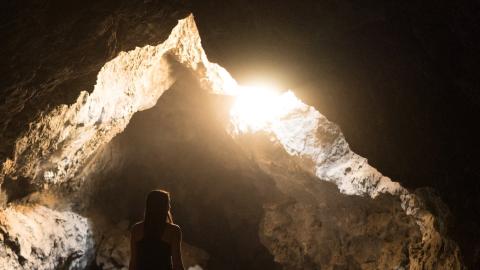
Like the resurrection itself, John 20:1-9 raises several interesting questions. Why is there so much detail about the burial clothes? Why accentuate the running back and forth of Mary Magdalene and the disciples? What did the one disciple actually believe in when it says, “and he believed”? What is the significance of Mary of Magdala arriving when it is still dark? But for me, the most intriguing question at the end of 20:9, is what actually happened to Mary Magdalene?
This last question is quickly answered in the next section of John which was not read today. In John 20: 11 and forward, we hear “Mary of Magdala stood outside weeping!” And once the disciples left without saying a word to her, even though she was the one who called them to the tomb in the first place, Mary looked inside and spoke to angels who, interestingly enough, had not appeared to the two disciples. In reply to why are you crying, she said, “They have taken away my Lord and I do not know where they have laid him.” Returning outside she challenges the gardener, “If you have carried him away tell me where you have laid him and I will take him away.”
The structure of John 20 is a powerful invitation for us, as we celebrate this Easter feast, to dwell with Mary outside the tomb and feel with her what she is feeling: the pain and suffering of a sudden rupture in her life. A woman weeping as she struggles with loss. She has just experienced the violent execution of a loved one, Jesus, and that emotion is now intensified by the absence of his body. “They have taken away my Lord and I do not know where they have laid him.” It is a painful sense of loss in which even the rituals of burial and grieving have been stolen from her. Nothing makes sense. Nothing is right.
All of us who have suddenly lost loved ones, or employment or some other rupture in life, can relate to this sense of disorientation, and dislocation that Mary is feeling. Most recently we see Mary’s pained face in the faces of those weeping in Turkey and Syria who lost loved ones in the earthquake and continue searching for their bodies. We see Mary’s tortured face in the faces of those weeping in Ukraine as they search the aftermath of intense bombing for their loved ones. They search, just as Mary searched, weeping outside the tomb, not expecting to find them alive, but at least to carry out the very important rituals surrounding death and grieving. Those rituals bring a balm to the rupture and sting of loss to those who perform them. And in a certain way, they are a form of resurrection for them.
But Mary went on to recognize the risen Lord when he called her by name, Mary, and she knew his voice. Through this verse, John is recalling Chapter 10 of his gospel in which Jesus is likened to the Good Shepherd who knows his sheep, calls them by name and they know his voice. The deeper sense of resurrection then is that in all the loss and suffering of our lives, we have the faithful assurance that we are known by name and cared for by the Risen Good Shepherd.
Father John Sivalon MM is a returned Maryknoll Missioner who worked in Tanzania.
Photo by Joshua Sortino on Unsplash
